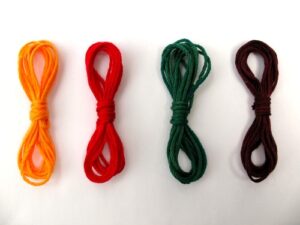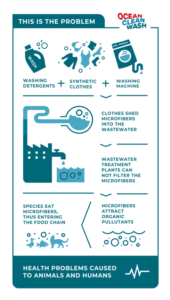Plant based fabrics are on the rise. There are many reasons for it. In 2017, a bunch of scientists from the French national research institute went up above 2877 meters above sea level at the Pic du Midi Observatory. Between the month of June and October, these researchers took samples of the air, which was considered clean, to test for pollutions. The French hill station is called a “clean station”. Until that study, people believed that there are places on earth where pollution does not reach. But this study totally changed the way thought about pollution.
After testing the air samples, the researchers found out that the air contained microplastics in them. These microplastics are not visible to the naked eye. It’s roaming in the air getting inside the body through breathing. What’s fascinating about this study is that the researchers couldn’t understand from where these microplastics originated. The researchers later found out that these microplastics originated from ocean water through evaporation. Once it gets into the troposphere, the microplastics travel around the world.
Plant Based fabric do not have microplastics

Synthetic fibers like polyester, acrylic, and nylon are widely used around the world. These fibers are easy to make and can offer cheap products to the customer. Synthetic fibers represent around 60% of clothing materials worldwide. Among them, polyester is the most used. Polyester is popular because of its availability, durability, resistance, and affordability.
Synthetic fabrics lose tiny plastic fibers while it is being manufactured, washed, or worn. These microplastics end up in the environment. Ultimately in the air and ocean.
”Microplastics are tiny pieces of plastic, that are smaller than 5mm which is not visible to the naked eye. It is released directly into the environment due to the degradation of its components”
How does wearing and washing synthetic clothes create microfiber pollution?
Almost 35% of the microplastic pollution in the ocean is contributed by washing synthetic clothes. It is found out that each time we do our laundry, an average of nine million microfibers are released into the wastewater. The challenge here is that the wastewater treatment plants cannot filter out these microfibers. Hence, it always ends up in the ocean. Through evaporation, these microfibers are freed into the air. It gets into the human body via water and air.
From the image below we can clearly see how the microfibers end up inside our food chain. The animals and birds are also a victim of our activities.
I’m frightened? What can I do?
The microfiber problem is a very complicated issue. Only after significant pollution occurred, these issues were discovered. The scale of this problem is global and cannot be solved without the help of everyone involved in the supply chain. The best way to avoid this problem is to not buy synthetic fabrics that are harmful to the environment. Replace these fabrics with natural and biodegradable fabrics. This decreases the demand for synthetic clothes and could ultimately push brands to produce only natural and biodegradable clothes.
Plant-Based Fabric – An alternative
The ongoing climate crisis coupled with the pandemic has really opened our eyes. People are looking for healthier products that can add value to their health and the environment they are living in. The clothing industry is highly saturated with cotton and linen. Most people prefer these fibers. But now, consumers have more than these natural fibers to choose from.
Hemp fabric, Banana fabric, etc. are new-age natural fibers. The clothing made up of these fibers is similar to cotton or linen. Some have more benefits than traditional fibers. Besides, these clothes do not harm the environment.
“Plant-based fabrics are expensive, but at the same time, provide quality, richness at par with organic cotton, silk, and velvet. The look and feel of these plant-based fabrics are at par with the above-mentioned materials. There are a limited number of manufacturers who are completely into vegan, eco-friendly production” – Anjali Bhaskar, Designer.
What is plant-based fabric / clothing?

As it sounds, plant-based clothing is materials derived from plants and trees. It is vegan. But not all vegan clothing is plant-based. The major difference is that vegan clothing means clothes made from natural resources.
There is a growing demand for plant based clothing. Some of the most eco-friendly, plant based clothing fabrics are:
- Hemp Fabric
We have talked about the benefits of hemp fabrics a lot of times on our blogs. Besides being a plant based fiber, it also contributes towards cleaning the environment. It has soft and breathable features like cotton. Yet durable.
Read more about: Hemp fabrics
- Banana Fabric
Humans have been making clothes from banana stems since the thirteenth century. Even though the craft was forgotten with the popularity of cotton and other synthetic fibers, it is making a comeback. It has a silky smooth feel to it.
- Tencel Fabric
Tencel is a semi-synthetic fiber that has silky smooth features like rayon and viscose. It is derived from sustainably sourced wood pulp, mostly eucalyptus. Even though the manufacturing process includes chemicals and water, 99% of them are reused. Thanks to the closed-loop manufacturing system.
- Bamboo fabric
Bamboo fabric is a textile product made from the bamboo plant. For thousands of years, this product has been in existence. But with more and more consumers around the world is demanding alternative materials, bamboo fabrics are in huge demand these days. It is a natural-looking, soft and silky fiber.
Read more about: Bamboo fabric
Plant based fabrics will become more in demand as consumer emotions are towards helping the planet and saving the ecosystem. What are your thoughts on this? For plant based fabrics, please reach out to us.




